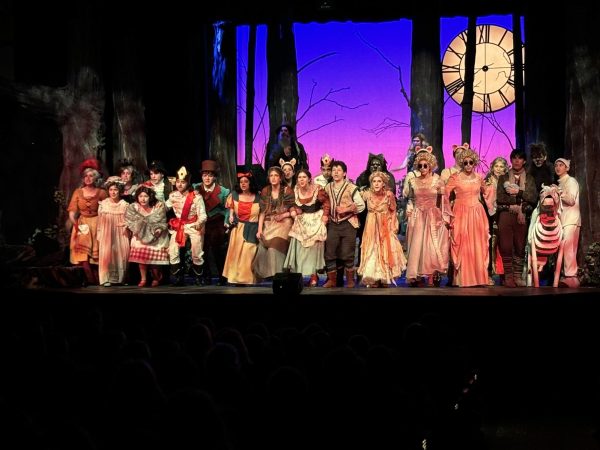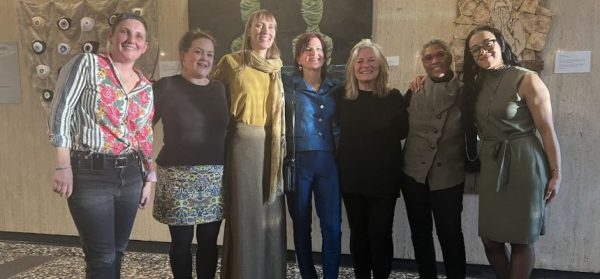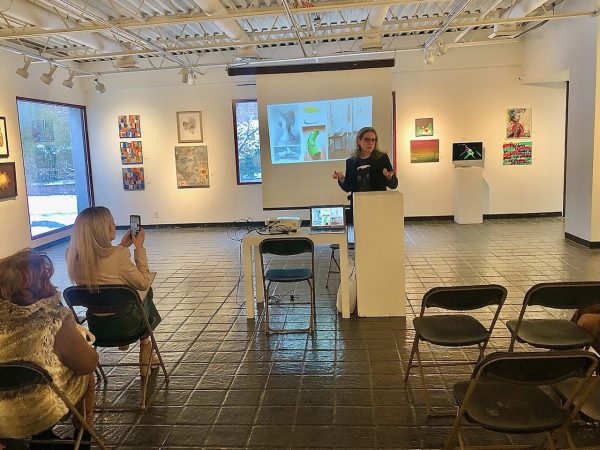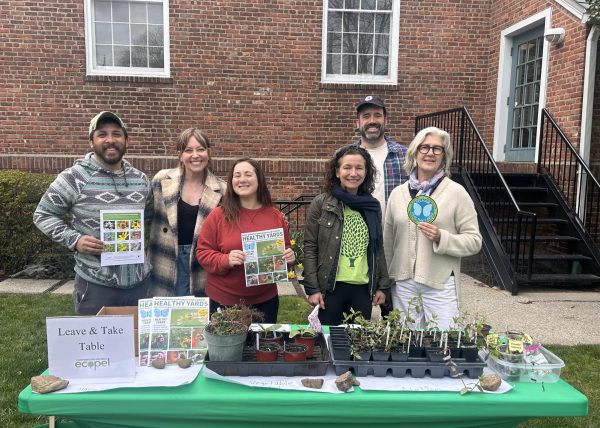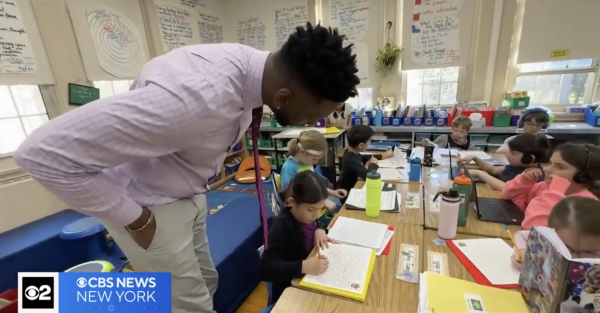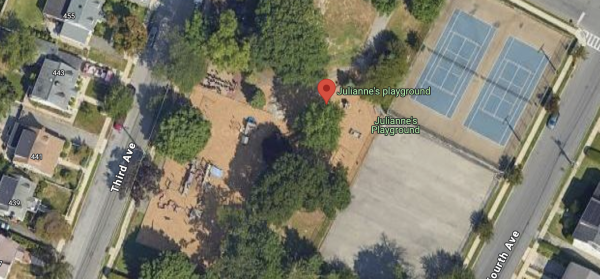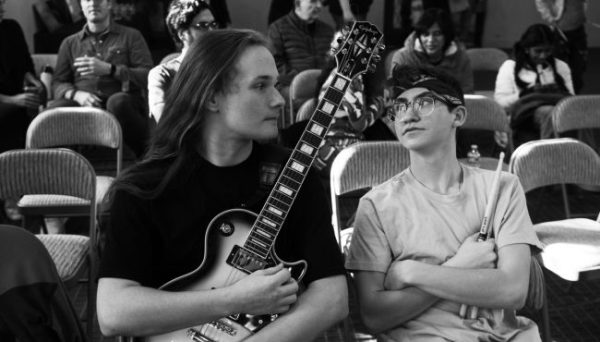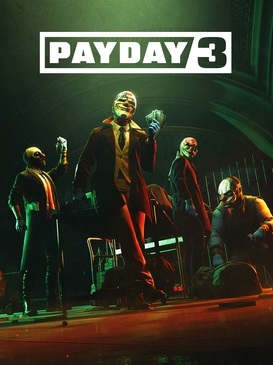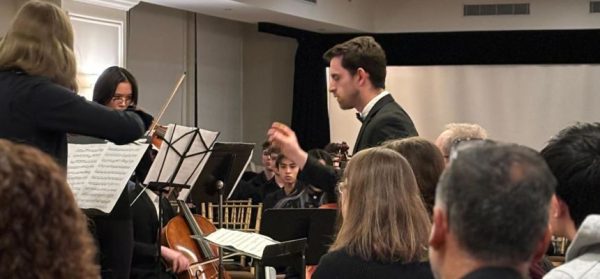‘What the Constitution Means to Me’ breaks boundaries but lacks political diversity

The lights are raised on the stage of the Hayes Theater to illuminate an array of American flags and dozens of framed portraits along the walls of the set. The portraits depict older, white men wearing field service caps and suits. The setting parallels an American Legion Hall in Wenatchee, Washington in 1989, the hometown where playwright and performer Heidi Shreck sets her scene. As she recreates onstage the constitutional debate contests she competed in around the country as a teenager, she asks that the audience act as the audience of American Legionnaires she performed for. Staring down from behind glass on the walls and from our seats in the crowd, she is surrounded on all sides.
From this position, Shreck strikes a public debate experiment and meditation on American democracy the likes of which Broadway has never before seen in “What the Constitution Means to Me.” After establishing the audience and context, Shreck dons a bright, yellow blazer and steps into the shoes of her fifteen-year-old self; lover of witches, Patrick Swayze in Dirty Dancing, and the United States Constitution. At first, the play is a delightful and didactic exploration of the Constitution as a testament to human ingenuity. Life is breathed into the document from the perspective of a smiley young girl with a passionate faith in her country and optimism for its future.
In the oration, Shreck highlights a particular interest she has in the 9th Amendment, which states that there are rights not explicitly listed in the Constitution which may not be violated. Her fascination with this “penumbra” of an amendment, as she refers to it, leads Shreck to discuss what and who is not included in the Constitution and how that has shaped American society. After an initial demonstration of how her younger self would answer the questions posed by the contest, Shreck peels away from the canon, taking the question out of context into the point of view of her older adult self. She begins to tell a different, personal story through her answers: how the Constitution dictated the lives of four generations of women in her family.
With heart-wrenching anecdotes and statistics, Shreck evaluates how our founding principles have rendered the women in her family vulnerable, designed to cater to property-owning white men alone. Starting with her great grandmother, who emigrated to Seattle as a $75 bride and died young due to “melancholia” after her husband dumped her on the steps of a mental institution, Shreck takes the audience through the strains of domestic abuse from her past and their struggles to testify, divorce, and seek abortions due to nuances in the U.S. legal system. She explains how the law of the land is not a set of ideals for show, but quite directly influences our roles in society and interpersonal relationships.
Beyond experiences in her family, Shreck hammers her point home by emphasizing that the word “woman” cannot be found in the Constitution. Thus, the rights of the Constitution are not specifically guaranteed for women. She reveals that the treasured 14th Amendment asserts that no “person” can be denied equal protection under the law without actually establishing that women are people. When the Equal Rights Amendment failed to pass, the legal system again left women unprotected against violence. In the historic case of Castle Rock vs. Gonzalez in 2005, Justice Scalia wrote that “shall” does not mean “must” in regards to the 14th Amendment due process clauses; as in, “law enforcement shall protect victims of domestic abuse” does not mean must. As a result of the ruling, Jessica Gonzalez was unable to sue the police for ignoring multiple reports that her husband kidnapped and killed their three young daughters.
As Shreck expands upon her full relationship with the Constitution and how it ignores most of us, she is overwhelmingly human, real, honest, and open. She wants the audience to go through the motions with her. One minute she would leap across the stage on a passionate tangent, and the next she would choke up revealing, “More American women have been killed by violent male partners in the last century than Americans have been killed in wars, including 9/11.”
And yet Shreck maintained a genuine optimism throughout that the country was still united by a collective faith in the Constitution, and that we had the power to determine how it would shape the next generation of women.
It was something I had never expected to see on Broadway- too interactive, too unconventional a story structure, the fourth wall broken too frequently. It was purposefully messy, unpolished theater you would expect to see in a black box theater at the Edinburgh Fringe Festival. Only, it was always meant for an American audience.
Yet this is what bothered me about this production. “What the Constitution Means to Me” is a relatively objective review of our founding document, illustrating the beauty in its ideals but discussing how its ambiguity has been abused as a tool for oppression. I was thrilled to learn that its 2018 debut would be ending in August 2019 to embark on a national tour, because the Broadway crowd is not exactly Wenatchee, Washington. In the case of my audience, there was constant audible affirmation of Shreck’s political views which did not infrequently emerge from her story. If there were any dissenters, they were far outnumbered by the liberal voices cheering on Shreck’s occasional outbursts against President Trump’s administration or immigration crisis, or joyous exclamations at the result of the 2018 midterm elections.
At the conclusion of the play, there was a substantive debate on the merits of abolishing or keeping our current Constitution. Every demographic in America has been angered by the political moment we are experiencing; the lack of transparency, corruption in our democratic structures, and the disparity between corporate-funded representatives and constituents suffering at the hands of those corporations.
Regardless of political sway, people are angry at the system, and the Constitution can play a large role in the repair of that system, as Shreck stresses. Everyone must be included in this conversation, not just those who share specific Shreck’s story of generations of domestic abuse enabled by the Constitution.
Metaphorically encircled, Shreck frequently brought up the demographic of straight, white men in America, discussing their role in abuse against women or their role creating and dictating the laws of the Constitution. She then rounded out the arguments by highlighting the fact that she was generalizing that demographic, and that the solution was for a range of people to be seated at the table to decide how America’s founding document would govern.
And yet, the actor she chose to play the timekeeper in the American Legion contest broke character later, admitting he was a gay man who had faced gendered discrimination because of his sexuality. Once again on the other side of the power dynamic between straight, white men and the rest of the world. And the actress who participated in the debate with Shreck about whether to abolish the Constitution at the end of the show? A young black girl from New York City trained in debate. It was heartening to see a young woman of color refuse to participate in the patriarchal hierarchy of U.S. culture, and I understood that Shreck looked to give voice to those who were never granted one. But I couldn’t help but leave dissatisfied with her thesis.
To tackle issues of domestic abuse, abortion, racism, immigration, and a lack of diverse representation, you must include both the demographic being oppressed and the demographic instigating the oppression, whether consciously or not. Straight, white men aren’t going anywhere, and there is little point in trying to champion progress when we write off those who are perpetuating this culture or whose ancestors historically perpetuated it. There can be no sustainable balance of justice in our country if we simply usurp the ruling class.
“What the Constitution Means to Me” has done its part to establish that art is an essential piece of our national dialogue. But that national dialogue cannot afford to leave anyone behind. What I would have loved to see at the end of the play is a white boy debating with the black girl about whether to abolish or keep the Constitution, participating in the conversation knowing he is not the enemy and is in fact just as vital to solving these societal issues as his debate partner.
Violet Massie-Vereker is a senior at Pelham Memorial High School. Her experience in journalism includes writing for the News of Pelham for the past two...



